Ampalaya Guisado: Bitter Melon Sauteed in Tomatoes, Onions and Scrambled Eggs
As an Amazon Associate and member of other affiliate programs, I earn from qualifying purchases.
A big “bandejado”, an oval serving platter in most Filipino homes and pronounced ‘ban-de-ha-do’, containing the Ampalaya Guisado: Bitter Melon Sauteed in Tomatoes, Onions and Scrambled Eggs was a mainstay on our family table almost every week. Admittedly, the ampalaya also known as bitter melon or bitter gourd, cooked by my mom was far better tasting than the dish made by the nuns at my school. But that’s another post for next time. And yes, I liked mom’s version better, it was infinitely far more marvelous so I didn’t need to be forced to eat it.
The Filipino ampalaya has been misunderstood over the years. Children sneered, screamed and push back their plates if they saw it. I know, I was once one of those kids. But as I got older, I began to appreciate vegetables for their distinctive flavors, how much I felt better eating them in the long run, and how much more refreshing it felt to have it with meals. Also, my mom was a whiz in the kitchen and she knew just how to make the “amargoso” (bitter in Spanish) a sumptuously amazing vegetable dish.
Ampalaya (say ‘am-pa-la-ya’ ) was defined as bitter melon, “momordica balsamina” by the late Professor Doreen Gamboa Fernandez, pioneer Filipino food writer and culinary expert on all things related to Philippine cuisine. In her book “Tikim”, Ms. Fernandez described the Filipino flavors of food in one of the chapters. Along with salty, sweet, sour is the word ‘bitter’. Yes, ‘bitterness’ is an added flavor to Filipino dishes. “Bitterness, with its underlay of sweetness, is the special discovery of the Ilocano”(referring to a northern region of the Philippines) explained Doreen.
Now that I’m all grown, and in my own kitchen, I love ampalaya, which I buy from Asian markets.
Prepare the ampalaya slices in a few short steps and you will lose the slight bitterness, regain a salty dimension and when you mix it with a heaping topping of tomatoes and scrambled eggs, then you get a slight sweetness.
Here’s the bonus, ampalaya has been known for its numerous nutrional benefits. I’m not claiming to be a nutritionist or expert in this field, but when I dug deeper here’s what I found the ampalaya can do:
The ampalaya can lower blood pressure, lower blood sugar levels, improve eyesight, treat blood disorders, can help cure cholera, builds the body’s immune system, is an effective antioxidant and a whole list more of curative effects. I confess I never knew this growing up. And now it all makes sense to me. Each ampalaya vegetable is packed with vitamins and minerals. It is also known to be high in dietary fiber and low in calories.
After I dredged the slices in salt, I squeezed the salt out with a cheesecloth. Then I blanched the ampalaya slices in boiling water for a few quick minutes.
The medium sized skillet over medium high heat sizzled with the garlic, onions and tomatoes. These combined aromas alone got my tummy rumbling in anticipation. I watched the garlic slivers turn golden brown, the violet onion slices turn a translucent dark red, and the chopped tomato cubes got soft and mushy. Quickly I added the fish sauce mixed with a little sugar, the broth and finally the ampalaya slices. It didn’t take long to soften them. They maintained their tart green colors as I mixed the ingredients around the pan, and the rivulet of broth got absorbed by the ampalaya slices.
The natural aromas of a good onion-tomato saute mixed well with the salty fish sauce. When I sampled a spoonful, the crisp ampalaya slices, now cooked slightly translucent were salty but gave me a hint of sweetness.
I scooped some of the scrambled egg slivers on the ampalaya and tart-sauteed tomatoes and it was heaven with a plate of rice.
Ampalaya Guisado : Bittermelon Sauteed in Tomatoes, Onions and Scrambled Eggs
Equipment
- Large skillet or Wok: 12 to 14 inches diameter
Ingredients
- 2 whole ampalayas (bitter melon) sliced, seeded, white membrane removed
- 2 Tablespoons salt
- 2 Tablespoons vegetable oil
- 2 whole eggs beaten and scrambled, sliced
- 4 cloves garlic crushed
- 1 whole red onion chopped fine
- 1 whole large tomato chopped in cubes
- 2 Tablespoons patis or Filipino fish sauce
- 1 Tablespoon sugar
- 1 cup vegetable broth
- 1 teaspoon black pepper powder
- boiled jasmine white rice for serving
Instructions
- Wash and slice the ampalaya in one-inch slices. Remove seeds and the white membrane. You should have half circle slices. Dredge the slices in the 2 tablespoons salt and set aside for 10 to 15 minutes. Afterwards, wash the ampalaya slices and drain. Wrap the vegetable slices in cheesecloth and squeeze the salt and liquid out of it.
- In a small saucepan of boiling water, blanch the ampalaya slice for three minutes. Drain quickly and pour cold water over it so it stays green. Set aside. The first step was to remove the bitterness from the vegetable.
- Prepare the eggs by beating them and then cooking them scrambled in a non stick skillet with the 1 tablespoon vegetable oil. This should take about 7 minutes. Set aside and slice in slivers for later use.
- In a large skillet, over medium high heat, add the remaining vegetable oil. Saute the garlic, onions, tomatoes. Allow these to soften in about 5 minutes.
- Add broth and patis or fish sauce. Finally, add the ampalaya slices. Blend all ingredients well. This sauted vegetables will cook in 10 minutes. Season with black pepper powder.
- Serve warm topped with slivers of scrambled eggs and a large plate of steamed jasmine white rice.
- Cook's Comments: You can also add sliced bits of pork or ground beef in the early part of the saute.
- Where to buy: The Ampalaya or bitter melon and the Filipino fish sauce "patis" can be found in Asian markets.
Hello, Friends! All the images and content here are COPYRIGHT PROTECTED. This means BY LAW you are NOT allowed to use my photos or content on your publications, website, videos or film without my permission. If you want to republish this recipe, please re-write it in your own words and simply link back to this blog to give proper attribution. It’s the legal thing to do. Thank you. Email me at [email protected]
Nutrition
Notes on Nutrition: The nutrition information provided is an estimate and will vary based on cooking methods and specific brands of ingredients used.
Did you like this recipe?I have more Filipino Instant Pot recipes in my newest cookbook Instant Filipino Recipes: My Mother’s Traditional Philippine Cooking in A Multicooker Pot by Elizabeth Ann Besa-Quirino. I also have more classic recipes inspired by my mother’s cooking in my popular cookbook: My Mother’s Philippine Recipes. If you’re learning how to cook Filipino food or a fan of Philippine cuisine, buy my cookbooks and books on Amazon.com sold worldwide in paperback and Kindle format.
Copyright Notice: Hello, Friends! Please DO NOT LIFT OR PLAGIARIZE my original recipe, stories, photos or videos. All the images and content on this blog are COPYRIGHT PROTECTED and owned by my media company Besa-Quirino LLC. This means BY LAW you are NOT allowed to copy, scrape, lift, frame, plagiarize or use my photos, essays, stories and recipe content on your websites, books, films, television shows, videos, without my permission. If you wish to republish this recipe or content on media outlets mentioned above, please ASK MY PERMISSION, or re-write it in your own words and link back to my blog AsianInAmericaMag.com to give proper attribution. It is the legal thing to do. Thank you. Email me at [email protected]

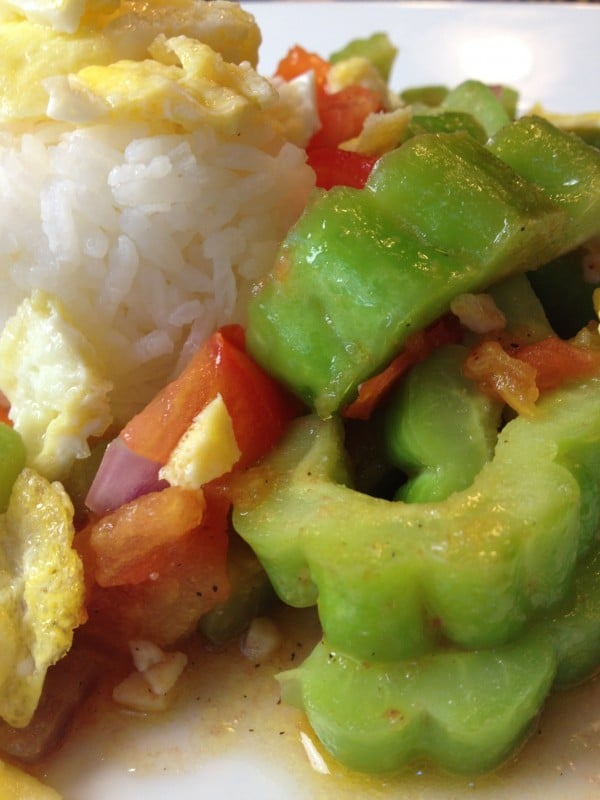
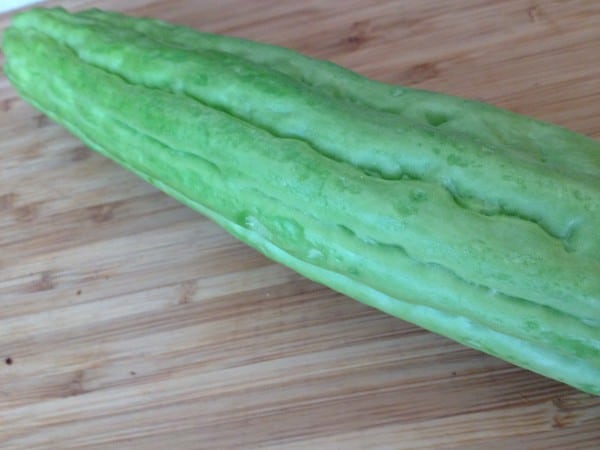
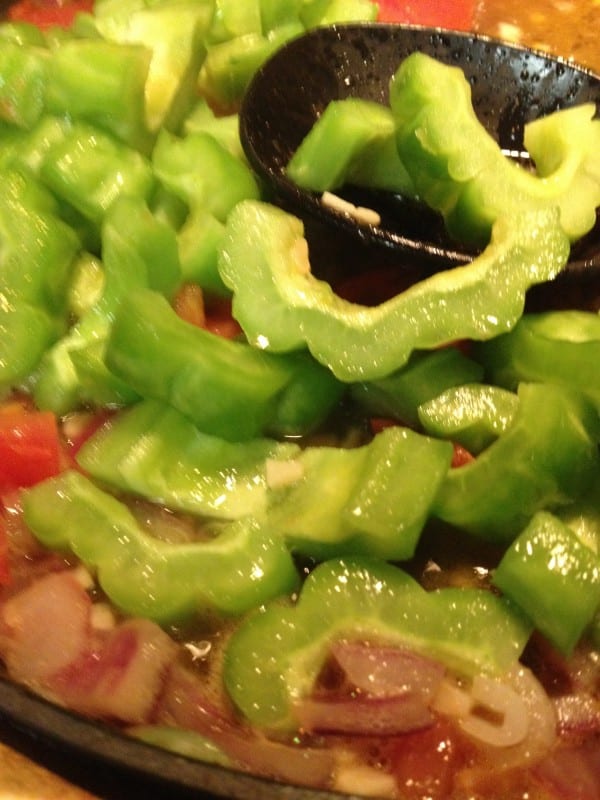
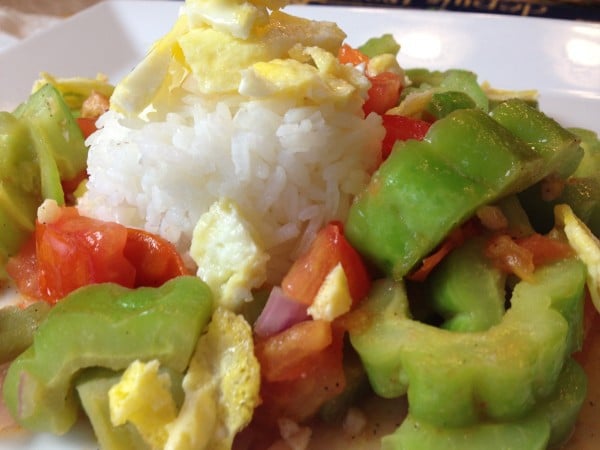
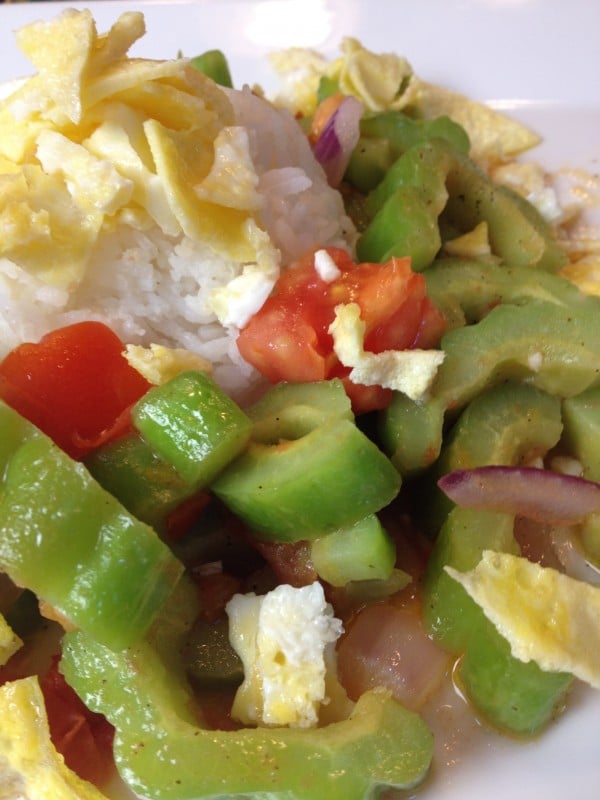

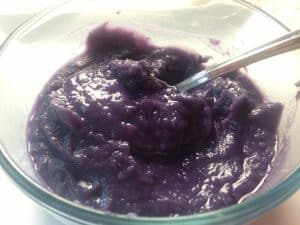




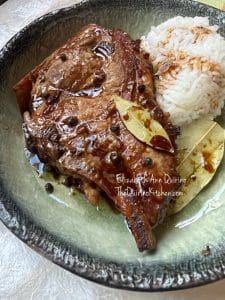
What a great post! I can totally relate to being forced to clean my plate. But substitute mushy-gross Wheaties on a Sunday morning for your ampalaya!
Isn’t it amazing how just a few extra simple steps can turn something kind of bitter and, well gross, into something with so much nuance? Love how you describe the dish. Makes me hungry:)
Thanks, Jenni! So sweet of you to stop by to shower me with blog-love. I learned from my Mom how to remove the bitterness and replace it with good food flavors. Moms always know how to make everything ok.
In zamboanga, the ampalaya is actually called “amargoso”. This makes me miss home so much! I used to hate ampalaya but I grew a fondness for it over time. My friends think I’m strange that I could stomach eating something so bitter. But coupled with a generous serving of rice, fried pork belly, scrambled eggs and a sprinkling of dried shrimps, it is, for lack of a better word, heaven. 🙂
Thanks, Gio! Nice of you to stop by 🙂 You just gave me some great ideas for another ampalaya dish — fried pork belly (crispy? yeah!), and dried shrimps? You’re right, sounds like heaven. I’m definitely making some more soon.
Elizabeth, I too was raised to eat what was served. I enjoyed reading this post from your experiences as a child, your culture and your exploits in the kitchen. Brava!
Additionally, I’m grateful you stopped by my place earlier today. Thank you for the kind words.
Thanks, Brooks! Nice of you to stop by and read my “veggie tales” !
I love ampalaya but I love the ampalaya con carne version…
Hi Peachy! Yes, same here – I love the con carne version and hope to make it again soon. Glad you came by 🙂
When i was a kid, I didn’t like ampalaya and my lola used to cook them a lot ! hahaha =) But i learned to cook, eat and love them !!! This recipe is definitely #1 intro to ampalaya dish (next is ampalaya con carne). Thanks for sharing !
Hi Chef Day! I like your story as a kid not liking it. Same sentiments here. But I now love it. I’m sure your version is super delish! Thanks for the blog-visit, my friend. Stay well !
OMG I remember those days that I was forced to eat.. and they would even say that after a spoonful, take a sip of water and the water taste sweet? hahah it didn’t work for me at all.
Glad you like amapalaya now but is till don’t tho…maybe sometime soon
malou
Hi Malou! I’m glad you share my sentiments about the awfulness of being forced to eat. But now that we’re older, we understand the nutritional value better. I’m sure with your creativity in the culinary arts, you’ll find a way to make an ampalaya dish that’s fabulous. Thanks for the blog visit!
Oh the dreaded amplalaya! There probably was a time when I didn’t like it (I don’t remember!) but I am pretty sure I love it already when I was about 8. After I tasted ampalaya con carne, of course. I miss this version with egg, yummy! I have to try this again soon.
Thanks, Iska! Glad you now like the ampalaya. Yes, the “con carne” version is yummy, I’ll try it soon. Nice of you to stop by.
Oh yes, ampalaya brings back bitter memories, pardon the pun. This vegetable that I use to hate became one of my favourites later on. Unfortunately, this is a bit pricey here in London so I can’t have it as often as I’d want to. I love the way you cooked it here, Elizabeth, as much as I love ampalaya con carne.
Thanks, Adora! It sure is a bittersweet vegetable for most of us. We all had the love-hate-love relationship with this veggie! Glad you stopped by. I love London, btw!
Hahaha I was expecting this to come up! Didn’t we all have bad days being forced to eat ampalaya in our childhood! Perhaps we’re better persons now for it, heheh, after those bitter moments. Great story, thanks!
Thank, Kai! You’re right, we’re all better off now after all the vegetables we were taught to eat. Glad you stopped by.
Nice post! Your ampalaya guisado looks so appetizing, Elizabeth!
I must admit that ampalaya is one of those few veggies that I don’t enjoy much especially when I was a kid. But it was my mom’s favorite and I always ate whatever ampalaya dish my mom cooked. She was so good in making it less bitter. Just like you, she would dredge ampalaya in salt, but she doesn’t squeeze it. She would just soak it in water for about 30 minutes and drain it after.
Hi Tina,thanks for the kind comments.I learned how to squeeze the salt out of the ampalaya from other family members. It was just one of those things you watch others do while in the kitchen. You’re right, moms always knew how to do this veggie dish right!